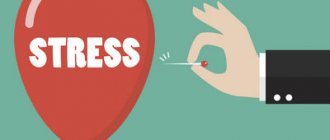Surely most of you have heard the phrase “Conquer yourself and win thousands of battles.” It is this phrase that reflects the whole essence of psychological self-regulation. The ability to control yourself, control your emotions and behavior in various situations is a very important and vital factor for survival in modern society.
Practiced and properly understood self-regulation contributes to prosperity and the fight against stress. To allow yourself to reach this level, you need to be clearly aware of all the types and features of self-control.
What is self-regulation and its types
Therapy specialist Andrea Bell defines self-regulation as the ability to control and restrain oneself from impulsive actions and emotions. The ability to self-regulate helps to resist and thereby control one’s place in society, which indicates the flexibility of a person’s emotional and behavioral state.
In psychology, there are two types of self-regulation:
- emotional - this is the ability to manage your state and emotions. In a moment of depression, lift your mood and the ability to calm down during a period of upset feelings,
— behavioral is the ability to act for the benefit of one’s long-term interests. More precisely, it is the ability to react to various situations, contrary to your feelings.
This is easy to understand using the example of a queue at the checkout. When you are tired, and the cashier is slow and clumsy, and even makes mistakes that lead to proceedings. To his apology and question whether he delayed you too much, you would rather answer, no, with a smile on your face, rather than express everything that you think about him.
For example, correctly developed self-regulation can also include:
- the child stops hysterics when asked to buy him a new toy in return,
- the decision of people to take a break in a sharp discussion in order to prevent a quarrel and not lead the situation to insults,
- choosing low-calorie foods if you want to lose weight.
Such control of emotions helps to achieve certain goals, solve many important problems, and even become a leader in your environment.
It is important to understand that self-regulation includes and makes the following human abilities stronger:
- using self-control to behave with dignity in society and not succumb to weaknesses: alcohol, smoking, using swear words,
- the ability to manage your energy in order to properly distribute the load and achieve desired goals,
- ability to maintain calm and restraint in unpleasant and difficult situations,
- the ability to switch and cope with workload and stress in difficult situations.
It is stress and stressful situations that are decisive factors in self-regulation and the ability to manifest it consciously and unconsciously.
Advice from a psychologist: special self-regulation techniques
As we have already discussed in the previous article, our immunity directly depends
from our emotional state. To support it and help your body, it is very important to relieve emotional stress, change the sign of emotions to positive and normalize the state of our soul and body.
In the previous article we discussed natural ways of self-regulation. Today we’ll talk about special self-regulation techniques. We remind you that self-regulation is the management of one’s psycho-emotional state, achieved through the process of a person’s influence on himself. During self-regulation, a person uses various techniques to control his breathing, muscle tone, consciousness, imagination...
Breathing control is an effective way to influence muscle tone and emotional centers of the brain. Slow and deep breathing (with the participation of the abdominal muscles) reduces the excitability of the nerve centers and promotes muscle relaxation, that is, relaxation. Frequent (chest) breathing, on the contrary, ensures a high level of body activity and maintains neuropsychic tension. The main thing in regulating breathing is to do it correctly.
Let's take a closer look at the breathing process. The respiratory act consists of three phases: inhalation, exhalation and pause. The lungs, which do not have their own muscles, follow the movements of the chest and diaphragm. The diaphragm is the strongest muscle for inhalation, and the abdominals are the strongest for exhalation. During the inhalation phase, the diaphragm contracts, while its dome moves to the bottom. At the same time, the stomach protrudes a little. The diaphragm presses on the insides of the abdominal cavity, massaging them. Intra-abdominal pressure increases and intrathoracic pressure decreases. This creates a “sucking” moment for air into the lungs and a “pushing” moment for blood from the venous depot of the inferior vena cava system and liver bile. As a result, blood circulation in the liver, spleen, and kidneys is stimulated. Blood is pushed towards the heart. In this regard, the diaphragm is called the “second heart”.
When you exhale, the abdominal muscles and intercostal muscles contract, and the diaphragm rises, taking on a dome-shaped position. Air is pushed out of the lungs. After exhalation there is a short pause and a new breath.
Diaphragmatic breathing is the most correct way for the body. This is how small children breathe. Modern people, born and raised in the city, are accustomed to a different breathing - superficial. With this method of breathing, only the upper parts of the lungs are involved, and the diaphragm almost does not work.
to begin mastering diaphragmatic breathing is to lie on your back with your knees bent. Inhalation must be done through the nose. In this case, the diaphragm lowers and the anterior abdominal wall protrudes. The belly should expand slowly, like a ball being inflated. At this time, the abdominal muscles remain relaxed. When you exhale, the stomach goes deep inside, and the diaphragm rises (as if the stomach is “stuck” to the spine). During this breathing, the chest remains inactive. If you have mastered this breathing while lying down, you can move on to training while sitting and then standing.
Mastering the techniques of psychophysiological regulation of breathing means developing the ability to control your breathing through special exercises.
Breathing exercises
Exercise 1.
While sitting or standing, try to relax your body muscles as much as possible and focus on your breathing. On the count of 1-2-3-4, take a slow, deep breath (while your stomach protrudes forward and your chest remains motionless). Then hold your breath for the next four counts. Exhale smoothly to the count of 1-2-3-4-5-6. Hold your breath again before the next inhalation on a count of 1-2-3-4.
After just 3-5 minutes of such breathing, you will notice that your state has become noticeably calmer and more balanced.
Exercise 2. Paradoxical breathing “Frog”.
Lie on your back or sit comfortably. Place your hand on your stomach to control its movement. As you take a slow, deep breath, pull your stomach in (the opposite of diaphragmatic breathing), your shoulders do not rise. As you exhale, stick your stomach out as much as possible.
It is impossible to breathe frequently or shallowly in this way. You automatically reduce your breathing rate and increase its depth, which means you reduce nervous excitement. In addition, this method of breathing requires complete concentration on the process itself and distraction from the outside world, which helps to temporarily get out of a stressful situation.
Exercise 3.
Imagine that there is a piece of fluff hanging in front of your nose at a distance of 10–15 cm. Breathe only through your nose and so smoothly that the fluff does not flutter.
Exercise 4.
Exhale deeply. Hold your breath for as long as you can. Take a few deep breaths. Hold your breath again. And so on several times. This exercise helps in situations of irritation and anger.
The human body is created for movement, which is as natural and necessary for life as breathing. Movement allows you to relieve tension, balances, heals, and fills the body with energy. Under the influence of mental stress, muscle clamps and tensions arise. The ability to relax them allows you to relieve neuropsychic tension and quickly restore strength.
With the help of various postures and movements, you have the opportunity to control very subtle and at the same time absolutely real changes in the sphere of your feelings, thoughts and experiences.
Exercises to control muscle tone and self-regulation of movement
Exercise 1.
Since it is not possible to achieve complete relaxation of all muscles at once, you need to focus on the most tense parts of the body.
- Sit comfortably, close your eyes. Breathe deeply and slowly.
- Walk with your inner gaze throughout your body, starting from the top of your head to the tips of your toes (or in reverse order) and find the places of greatest tension. Often these are the mouth, lips, jaws, neck, back of the head, shoulders, stomach.
- Try to tighten the clamps even more (until the muscles tremble), do this while inhaling.
- Feel this tension.
- Relieve tension sharply - do this while exhaling.
- Do this several times.
In well-relaxed muscles you will feel the appearance of warmth and pleasant heaviness.
If you cannot remove the clamp (especially on the face), try smoothing it out with a light massage using circular movements of your fingers (massage for the face will be given as a separate exercise), and you can also simply grimace to remove the clamps on your face.
Exercise 2.
Stretching is helpful to relieve tension. It is important to stretch, not stretching the body in a straight line (as it can compress the muscles), but bending and twisting.
When stretching, you need to point the toes of your feet towards you and stretch with your heels.
Exercise 3
We offer you a special complex for muscle stretching. When performing it, it is important to follow several rules:
– Stretch muscles only when they are warm; cold muscles are prone to injury.
– When stretching, it is recommended to proceed slowly and carefully. Never try to stretch muscles by force. During such exercises, pain should not be allowed to occur.
– Each stretch should last no more than 30 seconds.
– Perform each exercise twice.
– As you stretch, continue to breathe calmly and evenly. This promotes relaxation of both muscles and psyche.
After each stretching exercise, take a break of about one minute.
Stretches the shoulder muscles, the lateral back muscles and the muscles of the back forearms.
Stand up straight. Place one hand on the back of your head. With your other hand, apply light pressure to your elbow. Slowly move that elbow towards your other arm. Maintain the tension for about 30 seconds. If you perform the exercise correctly, you will feel a slight stretch in the back of your forearm, as well as in the side of your shoulder and back. Now do the same exercise with the other hand. Repeat the exercise again.
Chest muscle stretch
Stand up straight and extend both arms horizontally in front of you. Your arms should be extended parallel to the ground, palms down. Now bend them at the elbows and move them apart and back so that both elbows are behind your back. Hold them in this position for about 30 seconds. Return to the starting position. Repeat this exercise again.
Wrist stretch
Extend your arms above your head and place your palms together as if you were praying, with your fingertips pointing upward. Now slowly move your clasped hands along your body as close to your head and chest as possible until you feel a slight stretch in your wrists and forearms. Stay in this position for about 30 seconds. Immediately after this, return to the starting position and repeat the exercise.
Stretching the hips and gluteal muscles
Sit upright in a chair with a backrest. Place your left foot on the thigh of your right leg. Grasp your ankle with one hand and your knee with the other, and gently and slowly move your leg toward your upper body until you feel a slight stretch in your hip and gluteal muscles. Stay in this position for about 30 seconds. Repeat the same exercise for the other leg. Then do it all over again from the beginning.
Stretching the thigh muscles
Stand in front of a chair with your feet shoulder-width apart. Place your left hand on the back of the chair, bend your right leg, take it back and grab the toe of the bent leg with your right hand. Then slowly and carefully pull your heel toward your buttock until you feel a slight stretch in your right thigh. Stay in this position for about 30 seconds. Then do this exercise for the other leg. Then repeat the exercise.
Stretching the calf muscles
Stand behind a chair with a backrest and lean on it with both hands. Take your right leg back so that your heel touches the ground. Then bend your left leg until you feel tension in your calves. Stay in this position for about 30 seconds. Then repeat the exercise with the other leg. Do it again from the beginning.
Exercise 4
To relieve muscle tension, you can do facial exercises.
- Stretch your lips into a smile, then pull them into a tube, repeat this several times. Use your tongue to circle the inside of your pursed lips several times clockwise, then repeat the same movement several times counterclockwise.
- Football in language. Hit your tongue from the inside first with your right cheek, then with your left. Repeat the exercise several times.
- Raise your eyebrows upward in surprise, then bring them to the bridge of your nose and so on several times.
- Make funny faces so that all the facial muscles are involved in the movement.
Exercise 5
Kneading your hands helps relieve tension and calm you down. Clasp your hands and rotate your hands in random order. Launch a wave with clasped hands. Hook your fingers in pairs like hooks (right hand on top, left hand on bottom) and pull them, first the thumbs, then the index fingers, etc. Change hands, now the left one is on top, the right one is below, also sequentially hook your fingers and pull.
Exercise 6. Acupressure
Acupressure is an outstanding rapid relaxation technique that helps relax the body and relieve muscle tension. By pressing a finger on certain areas of the body, we have a direct effect on blood circulation and the nervous system. One of the important acupressure points to stimulate in a state of fear and anxiety is on the forearm in line with the middle finger, about two fingers from the wrist, on the back of the hand. Press this point for a few seconds with your thumb.
Another anti-stress point is located on the back of the hand in the triangle between the thumb and index finger. This point is not difficult to find, as it is very sensitive to pressure. Massage it for a few seconds, holding it between the thumb and forefinger of your other hand, until a slight painful sensation appears.
Exercise 7
There are numerous reflex points on the sole of the foot that have a relaxing effect. They can be massaged perfectly using a tennis ball.
Remove your shoes and socks and place a tennis ball under the ball of your foot. Place your body weight on the ball until the pressure feels good and move your foot back and forth. Thanks to the pressure, nerve endings are stimulated, which, through reflex circles, help relieve tension in distant parts of the body.
Exercise 8
Lie on your back, relax. Now stretch so that your toes are pointed towards your head, that is, stretch with your heels. At the same time, try to reach the nearest wall with the top of your head. Turn your body into a taut string. And, holding yourself in such a tense state, sing all the vowels of the Russian alphabet: a-a-a, e-e-e, i-i-i, o-o-o, u-u-u, y-y- s, uh-uh, yu-u-u, I-a-a. With each exhalation, chant one letter. Ten vowels – ten breaths.
Exercise 9. “Kitty”
Helps relieve tension from the back muscles and restore the spine. Get on your knees, place your hands on the floor, straighten your back. Your body seems to form a “bench” figure. As you inhale, arch your back upward, like a hissing cat. As you exhale, bend your back (without bending your arms and legs), like a cat crouching to the floor when being stroked.
Exercise 10. Quick stretch of the spine.
Stand straight with your feet shoulder-width apart. Stretch your arms in front of you, clasp your fingers in a “lock”, bend your index fingers. Raise your arms above your head like an antenna. The head is slightly pubescent. Begin to stretch your entire body upward, but do not lift your heels off the floor. Stretch your arms and the top of your head up and your chin down. Stretch so that there is a feeling of stretching upward, as if standing on tiptoes (but do not lift your legs off the floor). Feel how your whole body is stretched like a string. Hold this feeling and release the tension, lower your hands. Do the exercise several times.
Popular wisdom says: “A word can kill, a word can cure.” The word is a very powerful tool. The second signaling system is the highest regulator of human behavior. The mechanism of verbal influence involves the conscious mechanisms of self-hypnosis, and there is a direct impact on the psychophysiological functions of the body. Self-hypnosis can be in the form of self-orders, self-programming, self-approval.
It is best to carry out self-hypnosis exercises in the morning, immediately after sleep, or in the evening, before falling asleep. Why? The work of our brain can be compared to the work of a computer. Like a computer, the brain operates at some electrical potential. Unlike a computer, however, the brain produces electricity, the frequency of which does not remain fixed. Sometimes the brain's electrical energy fluctuates rapidly, 20 times or more per second. Sometimes it oscillates more slowly, with a frequency of 10 or 5 times per second.
In electronics, it is known that the best circuit is the one that has the lowest impedance - the total resistance to current - because it produces the most power.
Scientific research has shown that the mode of operation in which the brain has the lowest impedance, the least resistance to the flow of brain electricity along the nerve pathways, and, therefore, operates in the best mode of mental activity, corresponds to a state of calm and balance. When a person is excited, overwhelmed by fear, irritation, anger, the functioning of the brain significantly worsens. When arousal exceeds the state of brain activity, it becomes completely impossible to concentrate on anything.
A person who cannot control his consciousness becomes weak and cannot cope with emerging problems. The efficiency of its activities drops sharply.
By consciously changing the mode of brain activity, you acquire the ability to successfully concentrate, which helps to increase the efficiency of the thought process. We can say that in a calm state, nothing prevents the brain from functioning normally; it seems to be separated from the body. He is completely free and thanks to this he has the opportunity to successfully solve the problems facing you.
This state naturally occurs in your brain when you fall asleep. But a person quickly slips through this valuable state and falls into sleep. In the morning, when you wake up, you exit sleep through this same optimal state and return to a faster brain mode. If you have the opportunity to wake up, lie in bed for a while and practice self-hypnosis, do it. If this is not possible, practice self-hypnosis in any free time. The difference will be that you will spend more time on the second method.
Remember that the wording of self-hypnosis should be formulated in the form of simple and brief statements, with a positive focus (without the particle “not”).
Exercise 1 “Self-orders”.
A self-order is a short, abrupt order made to oneself. Use self-command when you are convinced that you should behave in a certain way, but have difficulty doing it. For example, “Talk calmly!”, “Be silent, be silent!” - this helps to restrain emotions, behave with dignity, and comply with ethical requirements and rules of working with clients.
Formulate a self-order. Repeat it mentally several times. If possible, repeat it out loud (the self-order is given to yourself not in the morning, after sleep, or in the evening before bed, but at the time of a specific difficult situation).
Exercise 2 “Self-programming”.
If you anticipate difficulties in business or a difficult situation in advance, it is advisable to “look back” and remember your successes in a similar situation. Past successes tell a person about his capabilities, about hidden reserves in the spiritual, intellectual, and volitional spheres and instill confidence in his abilities. Think back to a time when you dealt with similar challenges. Formulate the text of the program; to enhance the effect, you can use the words “exactly today.” For example, “Today I will succeed,” “Today I will be the calmest and most self-possessed,” “It gives me pleasure to conduct a conversation in a calm and confident voice, to show an example of endurance and self-control,” “I can resolve any difficult situation.” Mentally repeat this text several times (preferably in the morning, while you are still in a semi-relaxed state, but you can prepare the words in the evening).
We offer you some options for successful phrases for self-programming:
— I realize the value of my life;
— The energy of life, the energy of youth is now always with me;
“I walk in triumph through my blessed life;
- I was born for happiness;
- I was created only for victories;
- My life is wonderful, and it’s getting even better every day;
- I radiate happiness;
- I enjoy life.
Exercise 3 “Self-approval”
In life, people often do not receive positive assessment of their behavior from the outside. This, especially in situations of increased neuropsychic stress, is one of the reasons for increased nervousness and irritation. Therefore, it is important to encourage yourself. In case of even minor successes, it is advisable to praise yourself, mentally saying: “Well done!”, “Good girl!”, “It turned out great!”, “I did it!”, “I did it!”. Find opportunities to praise yourself at least 3-5 times during the working day. Be sure to praise yourself before going to bed for the past day. Don't forget to praise yourself in the morning, in advance, just for being you.
Exercise 4
Successful planning and programming of your new work day works well. This is not quite ordinary planning, it will allow you to become the master of the situation, and not adapt to it.
Wake up 5 minutes before your alarm rings (the alarm should ring quietly). In the evening before going to bed, give your subconscious an instruction. Something like this: “I am now falling into deep sleep. All organs and systems of the body work clearly and harmoniously. I wake up 5 minutes before the alarm goes off, full of strength and energy, in a great mood.”
When you wake up, don’t rush to get up. Walk with your mind's eye through all parts of your body, feel how your body has rested and recovered. This will put him in a state of readiness.
After that, set a program for the day. Say your intentions to yourself. They should sound positive.
For example: “Today I rationally distribute my time between work and household chores. I find the most convincing and rational arguments in favor of my proposal, and successfully present my ideas to management online. The management approves of my proposals.” Then imagine the day ahead from the time you get up to the time you find yourself back in bed. Let the whole day pass before your mind's eye (draw in your mind pictures of the successful implementation of the plan). Don't try to plan too many things at once. After this you can easily get up. An alarm clock will help you if at first you fall asleep while programming your upcoming day.
The use of images is associated with an active influence on the central nervous system, on our ideas and sensory images. We don’t remember many of our positive feelings, observations, and impressions, but if we awaken the memories and images associated with them, we can relive them and even strengthen them. And if with words we influence mainly consciousness, then images give us access to powerful subconscious reserves of the psyche. With the help of the subconscious, we can not only reproduce pleasant memories, but also simulate desired situations.
Exercise 1
When it’s hard for you, remember situations, events in which you felt comfortable, relaxed, calm - these are your so-called resource situations. To do this, try to connect all your senses: visual images (what you see: clouds, flowers, forest, etc.); auditory images (what sounds do you hear: birds singing, the sound of rain, sounds of surf, etc.); sensations in the body (what you feel: the warmth of the sun's rays, splashes of water, the smell of blossoming apple trees, the taste of strawberries, etc.). If you feel irritated, tense or tired:
– sit comfortably, closing your eyes if possible;
– breathe slowly and deeply;
– remember one of your resource situations;
– live it again, remembering everything: visual pictures, sounds, body sensations;
– stay inside this situation for a few minutes;
– open your eyes and return to active activities.
Exercise 2
If you have mastered the previous exercise, you can experiment with thought forms. Think about an event from the past that was very pleasant for you. Pause for a moment to return to this memory, and make sure that you see what you saw when this pleasant event occurred. You can close your eyes if it's easier. Now, looking at this pleasant memory, change the brightness of the image and notice how your feelings change in response. First make the memory brighter and brighter, then dimmer and dimmer until you can barely discern it. Now make it brighter again. How does this change how you feel? There are always exceptions, but for most of you, if you make the picture brighter, the sensation will intensify. Increasing brightness usually increases the intensity of sensations, while decreasing brightness does the opposite.
Now think about an unpleasant memory that makes you feel bad. Make this picture more and more dim. If you turn down the brightness far enough, it won't bother you anymore. Brightness is one of many settings that can be used in this exercise.
Play with other variables in your thought forms. Select another pleasant memory and change the size of the picture. First, do it more and more, and then less and less, noting how your sensations change in response. The relationship is usually such that the larger picture strengthens your response, and the smaller one, on the contrary, weakens it. By changing the size of the unpleasant picture, you will probably find that making it smaller reduces your discomfort. Vary the color intensity from very bright colors to black and white. Vary the distance from very close to far. Try something else (depth, clarity, contrast, etc.). Try changing one element at a time first, then try combining them. Create resource pictures for yourself, even movies, and get charged with positivity.
Exercise 3
Sit comfortably in a chair, close your eyes. Imagine that in the very center of your being, your Self, there is a small particle that is very, very calm and happy. She is not affected by worries and anxieties, problems and troubles, fears and worries about the future. She abides there in complete peace, strength and happiness. You can't reach it, you can't touch it. If you want, you can imagine it in the form of a certain image - a tongue of flame, a precious stone or a hidden lake, calm, with a smooth surface without the slightest ripple. Filled with deep peace and joy, calm and strength, she is completely safe. It is there - deep inside you. Now imagine that this flame, this gem, or this lake, located deep, in the very center, in the very core of you, is yourself. Imagine that this secret center always resides within you, remaining there just as calm and quiet, no matter what difficulties, problems and worries you may have to go through, and that if you want, you can learn to remember at any time that this particle there. And many times a day you can remember this small kernel of inner peace and mentally join it. Knowing that it is here, very close, you will feel more calm and relaxed, and at the same time more confidence and strength in the upcoming interactions with people around you.
Exercise 4
Sit comfortably in a place that is calm for you. Close your eyes, breathe evenly, deeply and calmly. Relax as much as possible. Think about those who love you. Remember all the people both in the present and in the past. Introduce everyone personally. Plunge into the feeling of selfless and sincere love. Feel it, be filled with it. Having well remembered what you just felt, slowly and calmly return to yourself and get involved in everyday life on a wave of love.
Try, experiment and be happy and healthy.
The next article will be devoted to techniques for relieving negative emotions and ways to form positive emotions, ways to form positive thinking and a positive self-image.
Previous article
Next article
What is stress and why is it dangerous?
Stress is an invisible weapon that leads to the destruction of body cells and ultimately manifests itself through various diseases. After a stressful situation occurs, impulses are formed in the human brain that are sent to the cardiovascular, immune and endocrine systems. This is quite enough not only to disrupt self-control and lose vigilance, but also to cause a number of complex diseases. When stress becomes chronic, its effects can be devastating.
The famous neuroendocrinologist McEwen, winner of many prizes and awards, proved:
- prolonged stress has a very bad effect on human memory, which leads to atrophy of neurons,
— acute and prolonged stress suppresses the body’s immune functions, making it weak and defenseless to resistance,
— in the process of stress, the human body produces glucocorticoids, which in the short term have a beneficial effect on it. But as a result of prolonged stress and increased levels of glucocorticoids in the body, it prevents insulin from working in the body, which helps in the absorption of glucose.
It is important to note that stress interferes with:
- control your own fear,
- reduces reproductive functions in the stronger sex,
- damages teeth and gums,
- leads to imbalance throughout the body.
Methods of self-influence
So, methods of self-influence can be divided into:
- Related to verbal influence
- Movement related
- Breath-related
Let's look at each of them in more detail.
Methods of self-regulation associated with verbal influence
The impact of words is different in that it activates the conscious mechanisms of self-hypnosis. As a result, a direct effect on the psychophysiological functions performed by the body begins. As a rule, verbal self-suggestions are formulated through short and simple statements that do not use the particle “not.”
Verbal influence can be expressed in self-orders, self-programming and self-approval.
Self-orders
Self-orders are short and abrupt orders that a person gives to himself. A person should use self-orders when he is convinced that it is necessary to behave in a specific way, but there are some problems with organizing his behavior in this regard.
You should tell yourself something like: “Speak calmly!”, “Be silent, be silent!” or “This is just a provocation. Stop reacting!” - such self-importances will allow you to restrain your emotions and behave within the framework of decency, ethics and dignity.
You should work with self-orders like this:
- Self-order is formulated
- The self-command is repeated to oneself several times
- Self-order is pronounced out loud (if possible)
Self-programming
In some life situations a person needs to “look back”, i.e. Refresh your memory of past successes in similar situations. This can become an indicator that there are hidden volitional, intellectual, spiritual and even physical reserves in him, as well as indicate opportunities and give self-confidence.
You can set yourself up for success using self-programming. It is done like this:
- The person must remember a situation in which he has already successfully dealt with similar problems
- Then you need to use affirmation. To enhance the effect, you can give it the current tense, for example: “Now I can do this”, “Today I will be as confident as possible”, “Now I will be persistent as never before”, etc.
- After this, you should repeat the received affirmation several times (mentally, in front of a mirror, or simply out loud, if the situation allows)
Self-approval
Quite often, people cannot receive a positive assessment of themselves and their actions from the outside, which is very painful in situations with neuropsychic stress. A lack of positive evaluation can cause irritability, nervousness and even aggressiveness. For this reason, a person must encourage himself.
For self-approval or self-encouragement, you should simply say certain words to yourself, such as: “I’m super!”, “Well done!”, “Handsome!”, “Clever!”, “It worked,” etc.
Methods of self-regulation associated with movement
Mental stress initiates muscle tension – muscle tension. However, the ability to relax muscles can relieve neuropsychic tension and restore strength reserves in the shortest possible time.
In most cases, a person cannot relax all the muscles overnight, so it is recommended to focus attention on the most tense areas of the body.
The technique for effective muscle relaxation is as follows:
- You need to sit down and take a comfortable body position
- Then you should close your eyes and begin to breathe slowly and deeply.
- After this, you need to take an internal look at your entire body, starting from the top of your head and ending with your toes or vice versa, thus finding the most tense places (usually the stomach, shoulders, back of the head, neck, jaw, lips or mouth)
- The next step will be even stronger tension in the places of muscle clamps, up to trembling (you need to tense while inhaling)
- Now we need to try to feel the new tension
- And at the end you need to sharply relax (you need to relax while exhaling)
*This procedure must be repeated several times
If the muscle is relaxed really well, it will feel warm and pleasantly heavy. In the same case, if you can’t remove the clamp, you can try giving yourself a light massage on the tense area.
Natural self-regulation
By nature, every person has natural (or involuntary) self-regulation of states, i.e. Our psyche can deal with stress and recover on its own.
However, not all people have sufficient natural self-regulation of mental states: some people are able to cope with even the most severe stress without much effort, while others are unable to do this. Why is this happening?
The extent to which natural self-regulation of mental states occurs is influenced by three main factors:
- features of the structure of the psyche;
- Lifestyle;
- way of thinking.
Let's look at each of the above factors in more detail.
Features of the structure of the psyche
To determine the structural features of the psyche, the concept of “temperament” is used - this is a type of higher nervous activity, i.e. a set of stable dynamic features of mental processes that differ from each other in tempo, rhythm and intensity.
There are four main types of temperament:
- Sanguine (strong, balanced and agile).
- Choleric (strong, unbalanced and mobile).
- Phlegmatic (strong, balanced and sedentary).
- Melancholic (weak, unbalanced and inactive).
Sanguine and phlegmatic people can easily cope with stress, but melancholic and choleric people cannot. At the same time, melancholic people are more susceptible to sadness, sadness, apathy, and choleric people are characterized by increased aggressiveness.
Lifestyle
The phrase “a healthy mind in a healthy body” is known to everyone. The basic principles of a healthy lifestyle are moderation, benefit, regularity. This is the right approach to nutrition, physical activity, sleep, avoiding stressful situations and monitoring your health.
If your body is in a painful state, your psyche simply cannot cope with stress because it does not have enough resources. But a physically healthy person has much more strength to cope with stress.
Way of thinking
We perceive reality as we imagine it. And the way we perceive it directly affects our emotional and physical state.
Cognitive distortions can cause the emergence and development of negative conditions even if a person is absolutely healthy, both physically and mentally. Irrational attitudes (beliefs) make us experience stress even in cases where there is no real threat to our condition, or make it disproportionate to the real state of affairs. But rational cognitive attitudes allow us to effectively cope with even the most difficult life situations.
To change your way of thinking, you need to:
- fight cognitive distortions;
- train a sense of humor;
- learn to manage your attention;
- master the skills of self-motivation and self-control.
It is precisely because of differences in the structure of the psyche, lifestyle and thinking that some people do not need to make any volitional efforts in order to return to normal, while other people simply need to do this in order to ensure emotional stability and mental stability.
The list of signals by which you can recognize that your psyche is not able to naturally cope with stress is as follows:
- increased irritability, conflict, imbalance, outbursts of anger;
- constant feeling of internal tension and dissatisfaction;
- decreased mood, constant sadness, lack of joy, apathy, chronic fatigue, lethargy, inability to enjoy life, lack of motivation, low performance and endurance;
- increased anxiety, feelings of fear, anxiety;
- lack of self-confidence, inadequate self-esteem, feeling of lack of willpower;
- sleep problems, overeating or unwillingness to eat, hypochondria, constant pain, etc.
If you notice these symptoms in yourself, you need to change the way you live and think, and also learn volitional (or voluntary) self-regulation.
Exercises based on breathing concentration
(Before the exercises: imagine an inflatable balloon or ball, remember how a thin stream of air comes out of it if you untie the balloon or open the ball. Try to mentally see this stream of air. We will imagine each of your exhalations as the same stream of air coming out of the points which we will open).
- Focus on your breathing. Breathe as usual; Notice your inhalation and exhalation. You can say with your inner voice: “Inhale,” “Exhale.” (30 sec).
- Feel your knees. Inhale. Exhale again through the points that you mentally “open” on your knees. (In fact, we exhale through our nose, but we imagine that we exhale through our knees). Inhale and exhale through the points on your knees. (30 sec).
- Feel your spine. Mentally “walk” along it from top to bottom. Find a random point at the very bottom of the spine. Inhale through your nose, and exhale mentally through the point that you yourself identified on the spine at the very bottom. Imagine a thin stream of air emerging from this point when exhaling (30 sec).
- “Climb” up the spine. Find a point in the middle of your spine. Inhale. Exhale through a point in the middle of the spine. (30 sec). We mentally try to “draw” our exhalation.
- Raise your mind to the cervical spine. Inhale. Exhale through a point on the cervical spine. Breathe like this. (30 sec)
- Feel your arms and hands. Inhale and exhale again through the points on the hands (30 sec).
- Mentally rise to your elbows. Inhale and exhale through the points on the elbows. Breathe like this, mentally imagining the air coming out (30 sec).
- Raise your mind to your shoulders. Find the points through which we will “exhale” on both the right shoulder and the left. Inhale and exhale through the points on the shoulders. Streams of air go up. We breathe, imagining these streams (30 sec).
- Find the point between the eyebrows. Inhale and exhale through the point between the eyebrows. (30 sec).
- Exhale through the point at the top of the head. (30 sec).
- Exhale the next time through all the points we mentioned. Breathe like this. Feel how the air passes through all the pores, through the entire skin (30 sec). Breathe calmly. Stay in this state for as long as you need. Come back refreshed.
(These exercises are useful for relaxation after strenuous work.)
Sound motor exercises
Such exercises use sound in combination with singing to vibrate certain organs.
It is believed that the sound “i” vibrates the pharynx and larynx, the sound “s” vibrates the brain, “a” and “o” - the chest area, “e” and “ou” - the lungs, heart, liver, stomach.
Sound vibration has a beneficial effect on all organs, especially the cardiovascular system, and enhances the body’s protective and adaptive reactions.
To relieve mental stress and negative emotional states, it is recommended to hum the sound combination “m-pom-peeee”: “M - pom” is short, and “pee-ee” is extended.
It is known that facial muscles can influence a person’s emotional mood; Therefore, it is necessary to accustom yourself to constantly maintain a kind, pleasant expression on your face.
To learn how to relax muscles, you need to have them, therefore, daily physical activity increases the effectiveness of muscle relaxation exercises.
The next self-influence technique is to control the tone of skeletal muscles.
The ability to relax, relieve muscle tension that arises under the influence of mental stress, allows the body to get complete rest, quickly restore strength and relieve neuro-emotional tension. As a rule, it is not possible to achieve complete relaxation of all the muscles of the body at once. Therefore, it is recommended to sequentially relax various muscle groups in compliance with a number of rules.
Firstly, the task of the exercise is to realize and remember the feeling of a relaxed muscle in contrast to its tension.
Secondly, each exercise consists of 3 phases: “strain – feel – relax.”
In the initial phase, the tension of a selected muscle group increases smoothly, then the maximum tension is maintained for several seconds until the muscles tremble, and the tension is released abruptly (relaxation phase). It must be taken into account that a completely relaxed muscle seems to “sag”, and a feeling of heaviness arises in it.
Thirdly, slow tension corresponds to slow inhalation, relaxation synchronized with a free full exhalation.
Each exercise is repeated 3-4 times.
Skeletal muscle is one of the most powerful sources of brain stimulation. Muscle impulses can change its tone over a wide range. It has been proven that voluntary muscle tension helps to increase and maintain mental activity and inhibit undesirable reactions to an existing or expected stimulus. To relieve irrelevant or excessive mental activity, on the contrary, muscle relaxation (relaxation) is necessary. Experiencing negative influences, the body mobilizes to the maximum for intense muscular work. So you need to present him with such work. Sometimes 20-30 squats or the maximum possible number of push-ups on the floor will help relieve mental stress.
In other cases, differentiated auto-training of the “express method” type will be more effective. It consists of maximally relaxing those muscles whose work is not currently required. So, if when walking, mainly the muscles of the legs are tense, then you need to relax the muscles of the face, shoulders, and arms. While sitting, you should relax the muscles of your face, arms, shoulders, and legs.
Let's get acquainted with one of the unique methods of managing internal resources to unlock abilities, overcome stress and psychological barriers.
Technique 1. “Divergence of hands.”
Hold your hands comfortably and give a mental command to your hands so that they begin to move apart as if automatically, without muscle effort.
Choose a comfortable look for yourself that will help you achieve this movement.
Imagine, for example, that they repel each other like unipolar magnets, or choose some other image. Whatever is more convenient. You can start by spreading your arms with a normal mechanical movement, and then with an ideomotor movement.
In order for your will to “work” and your hands to begin to move apart, you need to remove the obstacle between the will and the body (create a connection between the will and the body), i.e. find a state of inner balance within yourself.
To do this, you need to relax internally and feel comfortable. Do what is most pleasant, go through the options (tilt or bow your head, take a deep breath or exhale, hold your breath for a moment, etc.), the main thing is to find this feeling of inner comfort, in which your will will begin to influence the automaticity of movement.
Can be done with eyes open or closed. If your hands get tired, lower them, shake them, then try again.
Technique 2. “Convergence of hands”.
Spread your arms to the sides in the usual way, and now tune in to their automatic reverse movement towards each other.
Repeat it several times. Try the first technique - arms to the sides.
Repeat the divergence and convergence of the hands several times, achieving continuity of movement. At the moment when your hands seem to get stuck, you can push them slightly. Or smile, or sigh. A smile relieves tension. If the desired state of internal relaxation has arrived, stay in this state to remember it.
Technique 3. “Levitation of the hand.”
Hands down. You can look at your hand, then you need to do it continuously, or close your eyes. Tune in so that your hand begins to rise, “float up”. Remember how astronauts’ arms and legs “float” in zero gravity? If that doesn't work, go back to techniques 1 and 2.
When the hand begins to float up, a lot of new and pleasant sensations arise. For the first time, it will cause a sensation so unexpected that it involuntarily makes you smile.
Technique 4. “Flight”.
If the hand begins to “float up”, then after a few seconds give the opportunity for the same “float up” for the second hand.
Let your hands “float up”. Let them rise like wings.
Help yourself with pleasant imagery. Imagine that your hands are wings! Wings carry you!
You are high - high above the ground! Clear sky! Towards the warm sun."
Allow yourself to open to your breath. Allow yourself to breathe freely. Allow yourself to feel the state of flight.
Technique 5. “Self-oscillations of the body.”
When performing Key Techniques, along with relaxation, the phenomenon of self-oscillation of the body usually occurs. This is natural - when a person is relaxed, he sways.
When the body self-oscillates, you can lower your arms and simply sway on the waves of this harmonizing biorhythm, like a child sways on a swing. You can close your eyes or leave them open: whichever is more pleasant.
This technique with self-oscillations of the body also trains coordination. A person with good internal coordination is more resistant to stress, less susceptible to external influences than others, has greater independent thinking, and quickly finds a way out in the most difficult situations. Therefore, exercises aimed at developing coordination also build resistance to stress.
Technique 6. “Head movements.”
Standing or sitting, we lower our heads, relaxing our necks, or throw our heads back, whichever is more pleasant, and, remembering the experience with ideomotor movements of the hands, we cause ideomotor turns of the head in a convenient direction.
If this does not work, we mechanically rotate our heads in a pleasant rhythm along the line of pleasant turning points. This is a rhythm in which you want to continue the movement, and the neck tension eases.
You can find a moment when you can kind of let go of your head, and then it will go on ideomotor - automatically.
It is necessary to avoid painful or tense points, and if they appear, they should be lightly massaged. When you find a pleasant turning point when moving your head, sometimes you want to leave your head there. A pleasant turning point is a relaxation point.
You can help yourself find relaxation and use the movement of your eyeballs, horizontal or vertical, to find what feels more pleasant to you.
If you perform these techniques before going to bed, then when you leave the state of self-regulation, tune in to a pleasant sleep, leave the procedure with a relaxed feeling, with drowsiness, with the desire to sleep.
The “Relaxation by Contrast” exercise will help discharge negative emotional states and maintain a cheerful mood. Here relaxation is achieved through tension. You need to tense, for example, your hands, and then relax them as much as possible.
Exercises for concentration
Exercise 1.
- Sitting with eyes closed. You give yourself the command: “Right hand!” and try to focus on your right hand.
- After 10-15 seconds, the next command: “Left hand!”, then: “Right foot!” etc., focusing on different volumes of the body.
- Gradually you should move on to smaller volumes - a finger, a nail phalanx - and to more subtle sensations, for example, the pulse beating at the tip of a finger.
- At the end, the whole body is in the field of attention, observed calmly, against the backdrop of general relaxation.
Exercise 2.
Extend your arms at chest level and then slowly bring them together, keeping your palms parallel.
After several repetitions, the palms begin to “spring”, encountering the elastic resistance of the environment
You need to “blind” a ball from this invisible “field substance” and, helping with your hands, “absorb” it into yourself in the solar plexus area.
Assess the difference in conditions: before and after exercise.
Exercise 3.
Performed in pairs. One of the participants closes his eyes, and the second, taking his hands, slowly leads him around the room. It is very important that the “blind” person feels safe, completely trusting his “guide”.
The “guide” leads his follower along the wall, inviting him to evaluate the difference in the perception of space: to his left and to his right.
Swap roles in pairs. Focus on the mutually compensating role of the visual, auditory and kinesthetic analyzers.
Note: all concentration exercises should be done with a fresh mind, preferably 2-3 hours after eating. If there is any discomfort - headache, deterioration in emotional state - stop doing the exercise.
Formation of skills to relax the muscles of the face and hands
It is these parts of the body that have the largest representation in the cerebral cortex, and it is in these parts that muscle tension most often occurs, i.e. muscle groups are chronically in increased tone even when a person is relaxed. Constantly sending activating signals to the brain, they do not allow the psyche to rest, including during sleep, threatening a person’s internal balance. Therefore, it is important to learn to relax all muscle groups at least for a short time.
The work of the facial muscles begins with tension and relaxation of the forehead muscles (mask of surprise, mask of anger), and then the muscles of the cheeks, chewing muscles, and neck muscles.
Facial exercises:
- Stretch your lips in a smile as far as possible, similar to Pinocchio’s smile. Return to starting position. Repeat 5-7 times.
- Puff out your cheeks. Exhale the air, mentally inflating the balloon. Repeat 5-7 times.
- Place your hand on your forehead. Trying to raise your eyebrows and eyes upward without wrinkling your forehead. Repeat 5-7 times.
- Close eyes. Close your eyes tightly. Feel that it has become dark. Cover your eyes with your hands. Feel that it has become even darker. Imagine in front of you a dark bottomless well, black velvet, something black. To feel that it has become even darker, to see, to feel this darkness. Be in it. Remove your hands from your face. Feel that it has become lighter. Without opening your eyes, feel that it has become lighter. Slowly open your eyes. (Going back is twice as slow). The exercise is performed 1 time.
- Make swallowing movements.
- Raise the corners of your lips up, smile, feel how pleasant sensations from the corners go to your ears.
- Run your hand over the neck muscles and, if they are tense, make several tilts and rotational movements with your head, massage your neck. Then lightly stroke the muscles from the shoulder to the ear, and rub the behind-the-ear tubercles with your fingertips. This improves blood flow to the head and helps relieve nervous tension.
If the clamp cannot be removed, it can be smoothed out using light self-massage in a circular motion with your fingertips. The end result is the achievement of a “relaxation mask”: the eyelids are lowered, all the facial muscles are smoothed, the face becomes somewhat sleepy, indifferent, the lower jaw of the face is lowered, the tongue is slightly pressed against the teeth, as if about to say “yes”.











